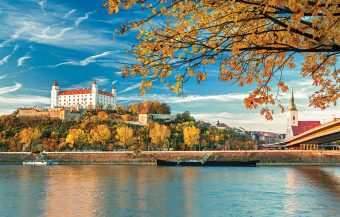
Over 40 per cent of the territory of a small country in the heart of Europe – the Slovak Republic, with a population of 5.5 million – is covered by forests. Slovakia is the seventh most forested country in the European Union judging by size. The country has impressive mountain landscapes with many different natural attractions like the Tatra Mountains, the Danube, high mountain peaks which alternate with deep valleys, vast forests interspersed with meadows and pastures and fast streams flowing into calm rivers. The nature here has a very diverse flora and fauna, which is determined by the geographical location. In a conversation with H.E. Fedor Rosocha, the ambassador of the Slovak Republic in Serbia, we learned how this country faces challenges related to environmental protection and climate change, how much energy they produce from renewable energy sources (RES), how they are reducing their carbon footprint and preserving biodiversity, development of electric cars and what kind of support they provide to Serbia regarding environmental protection.
Q: Rapid technological changes and the energy crisis have created uncertainties when it comes to environmental protection and the fight against climate change. How does Slovakia face these new challenges and what are the most important strategies that the country has implemented to face the latest developments in environmental protection?
A: Environmental problems increasingly affect the economy, employment and the quality of life of our population. Furthermore, just like anywhere in the world, Slovakia is visibly affected by climate change, which will manifest in the form of environmental, economic and health problems in the future. The biggest environmental challenges in Slovakia relate to waste management, air quality and protection of habitats and species, mainly in forest, meadow and wetland ecosystems. The strategic document Envirostrategy 2030 defines our vision until 2030 while taking into account possible and desired future developments. It also identifies basic system problems, defines goals, proposes measures to improve the current situation and contains basic indicators of results that will enable the verification of achieved results. The goal is to achieve a better quality of the environment and a sustainable circular economy, based on the consistent protection of environmental components and the use of as few non-renewable natural resources and hazardous substances as possible, which will improve the population’s health.
IN FOCUS:
- RECYCLING PACKAGING AT LIDL: DONATE OR REDUCE THE BILL
- SOLARISE PRECISELY CALCULATES THE NUMBER OF PANELS NEEDED FOR ONE ROOF
- SUSTAINABLE WASTE MANAGEMENT WITH GREEN ENERGY
Q: How much does Slovakia annually invest in environmental protection and which resources and funds do you use to regulate this area?
A: The share of total environmental protection costs in our GDP is approximately 1.5 per cent. We established the Environmental Fund, via which the state actively supports financial investments in environmental protection based on sustainable development principles. The Fund is under the jurisdiction of the Ministry of the Environment and primarily provides subsidies to municipalities, e.g. for the construction of wastewater treatment plants, sewage or water supply systems or projects that address climate change. One of the ongoing projects is the utilization of bio-waste. In the period from 2007 to 2020, the Environmental Fund spent 723 million euros, which is 9 per cent of Slovakia’s total expenditures in this area. More than 40 per cent of the support was spent on the construction and modernization of the water supply infrastructure.
Q: How far along are you in implementing your plans for the reduction of carbon dioxide emissions and what are your further plans in that direction? How much energy do you produce from renewable energy sources annually?

A: Slovakia is one of the leaders in reducing the carbon footprint in the EU. Between 1990 and 2021, we almost halved greenhouse gas emissions. This was achieved in part due to the closure of many industrial enterprises that were major polluters and also due to an increase in energy efficiency in the economy and the implementation of stricter national legislation. Establishing a competitive low-carbon economy is a long-term priority of Slovakia’s energy policy. The key to achieving a low-carbon economy is the optimal use of RES, nuclear energy, decarbonized gases and innovative technologies that will contribute to the efficient use of energy sources. In 2021, Slovakia’s share of RES in the overall energy mix was 17.4 per cent. Electricity production from renewable sources amounted to 7,241GWh. Hydropower plants had the largest share (62.9 per cent), followed by wood with an 18.3 per cent share. Solar photovoltaic systems had a 9.3 per cent share and biogas 6.7 per cent. The share of waste energy utilization was 2.8 per cent. Geothermal energy is another suitable option for increasing the share of RES in the overall energy mix. Also, several geothermal power plants are currently being developed.
Q: The Danube is one of the biggest rivers that run through Slovakia and one of the country’s main symbols. How much do you invest in the Danube’s preservation and protection? How did you regulate the construction of mini hydropower plants (MHE) in the context of long-term environmental consequences?
A: The Danube is an important international river that connects many nations and creates a unique natural heritage with a range of water-dependent organisms. It supplies quality water to Žitný Ostrov, our largest underground drinking water reservoir. The Danube is one of the most valuable and endangered natural heritages in Europe. That is why it is extremely important to pay attention to the protection and restoration of the Danube’s nature and the preservation of its biodiversity, while at the same time, using the Danube economically, in accordance with European strategies. Small hydropower plants are relatively simple, technically undemanding energy structures. However, they are also associated with serious environmental and socio-economic impacts, which directly depend on the location and type of hydropower plant. Of course, the goal is to use the hydropower potential of watercourses with minimal negative impact on aquatic organisms and water-dependent ecosystems. Currently, the utilized hydropower potential of Slovakia is at 57.5 per cent.
Interviewed by: Mirjana Vujadinović Tomevski
Read the story in the new issue of the Energy portal Magazine RESPONSIBLE BUSINESS



